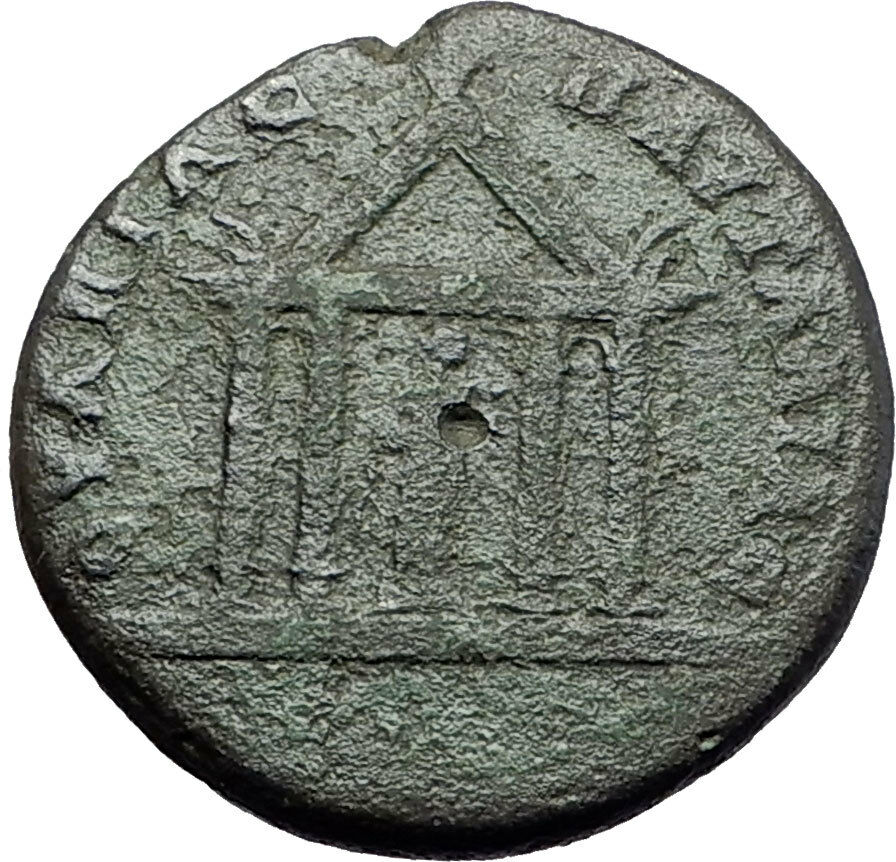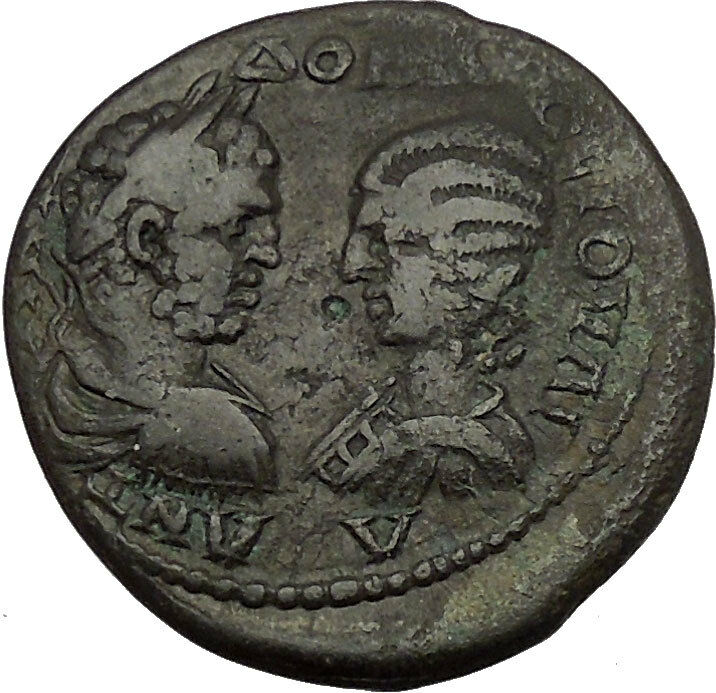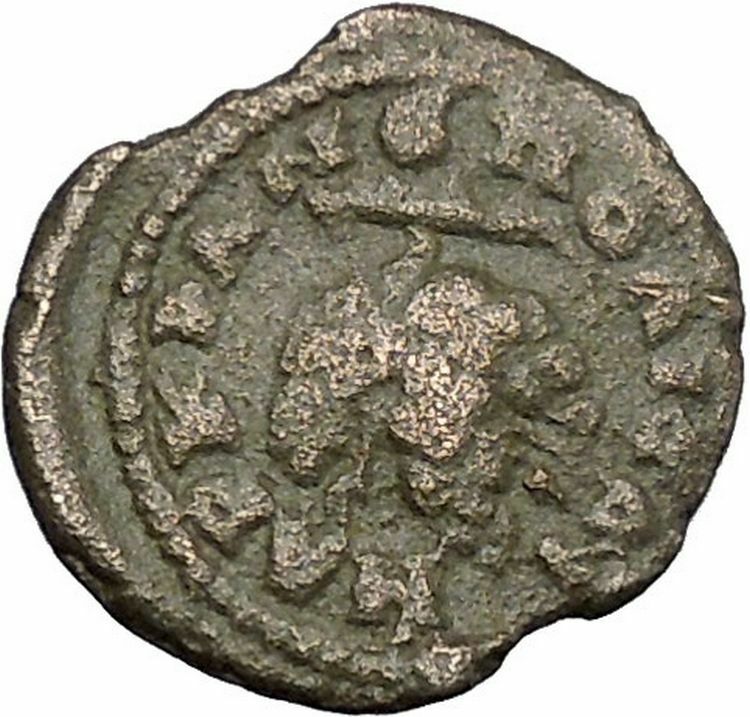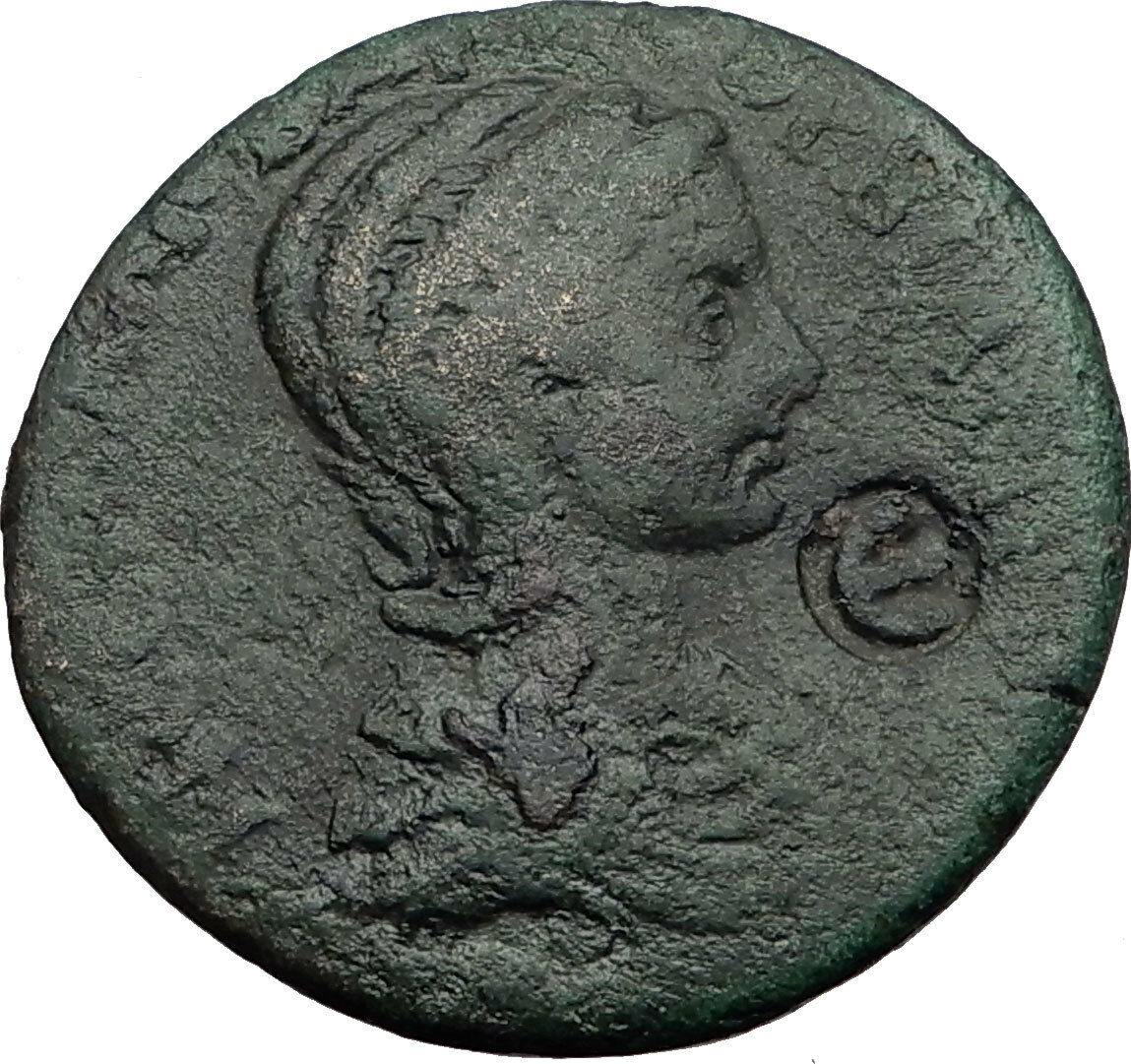|
Valerian I –
Roman Emperor: 253-260 A.D. –
Bronze 21mm (7.39 grams) of
Thessalonica in
Macedonia
AVT. K. ΠOΠ. OVAΛЄΡΙΑΝΟС,
Radiate, draped
and cuirassed bust right.
ΘЄCCAΛΟΝΙΚH. B. ΝЄ.,
Kabeiros standing left within two-column temple, holding rhyton and hammer;
fiery altar in field to left; another object to right.
This coin commemorates the city’s Neocorate states for the
second time. A rare, possibly unpublished type.
In Greek mythology, the
Cabeiri, were a group of
enigmatic chthonic deities. They were worshiped in a mystery cult closely
associated with that of
Hephaestus.
You are bidding on the exact item pictured,
provided with a Certificate of Authenticity and Lifetime Guarantee of
Authenticity.
In
Greek mythology
, the Cabeiri, (Cabiri,
Kabeiroi, Kabiri or
Greek
: Κάβειροι) were a group of enigmatic
chthonic
deities. They were worshiped in a
mystery cult
closely associated with that of
Hephaestus
, centered in the north Aegean
islands of Lemnos
and possibly
Samothrace
—at the
Samothrace temple complex
— and at
Thebes
. In their distant origins the Cabeiri
and the Samothracian gods may include pre-Greek elements Hittite, Thracian,
proto-Etruscan, or Phrygian elements. The Lemnian cult was always local to
Lemnos, but the Samothracian mystery cult spread rapidly throughout the Greek
world during the
Hellenistic
period, eventually initiating
Romans.
The ancient sources disagree about whether the deities of Samothrace were
Cabeiri or not; and the accounts of the two cults differ in detail. But the two
islands are close to each other, at the northern end of the Aegean, and the
cults are at least similar, and neither fits easily into the
Olympic pantheon
: the Cabeiri were given a
mythic genealogy as sons of Hephaestus. The accounts of the Samothracian gods,
whose names were secret, vary in the number and sexes of the gods, usually
between two and four, some of either sex. The number of Cabeiri also varied,
with some accounts citing four (often a pair of males and a pair of females) of
them, and some even more, such as a tribe or whole race of Cabeiri, often
presented as all male.
The Cabeiri were also worshipped at other sites in the vicinity, including
Seuthopolis
in
Thrace
and various sites in
Asia Minor
.
Origin of the Cabeiri
The Cabeiri were possibly originally
Phrygian
deities and protectors of
sailors
, who were imported into Greek ritual.
Robert Beekes believes that they are of non-Indo-European,
pre-Greek
origin.
Depiction in
literary sources
They were most commonly depicted as two people: an old man, Axiocersus,
and his son, Cadmilus. Due to the cult’s secrecy, however, their exact
nature and relationship with other ancient Greek and
Thracian
religious figures remained mysterious.
As a result, the membership and roles of the Cabeiri changed significantly over
time, with common variants including a female pair (Axierus and
Axiocersa) and twin youths who were frequently confused with
Castor and Pollux
, who were also worshiped as
protectors of sailors. The number of Cabiri also varied, with some accounts
citing four (often a pair of males and a pair of females) of them, and some even
more, such as a tribe or whole race of Cabiri.
Lemnos
The Lemnians were originally non-Greek; they were Hellenized after
Miltiades
conquered the island for Athens in
the sixth century BCE. In
Lemnos
the cult of the Cabeiri survived,
according to achaeological evidence, through the conquest: an ancient sanctuary
dedicated to the Cabeiri is identifiable by traces of inscriptions, and seems to
have survived the program of Hellenization.
The geographer Strabo
reported (Geogr. 10,3,21) that in
Lemnos, the mother (there was no father) of the Cabeiri was Kabeiro (Greek:
Καβειρώ) herself, a daughter of
Proteus
(one of the “old men of the sea”) and a
goddess whom the Greeks might have called
Rhea
.
In general Greek myth identifies the Cabeiri as divine craftsmen, sons or
grandsons of
Hephaestus
, who was also chiefly worshipped on
Lemnos. Aeschylus
wrote a play called the Cabeiri,
and the fragments that survive have them as a chorus greeting the
Argonauts
at Lemnos. showed them as prodigious
wine-drinkers, and wine jars are “the only characteristic group of finds” from
the Cabeirium of Lemnos.
Walter Burkert
suggests a raucous, burlesque
character to the mysteries of the Cabeiri and notes an inscription at Lemnos
indicates parapaizonti, the one who “jests along the way”. First-fruits
were offered to Zeus
,
Apollo
, and the Cabeiri; Burkert also sees the
offerings to Zeus and Apollo, father and son, as indicating an initiatory
ceremony
Samothrace
The Samothracians
were also originally non-Greek,
and are associated with the
Trojans and the
Pelasgians
; they used a foreign language in the
temple through
Julius Caesar
‘s time.
Samothrace offered an initiatory mystery, which promised safety and
prosperity to seamen. The secret of these mysteries has largely been kept; but
we know that of three things about the ritual, the aspirants were asked the
worst action they had ever committed.
The archaic sanctuary of Samothrace was rebuilt in Greek fashion; by
classical times, the Samothrace mysteries of the Cabeiri were known at Athens,
where Herodotus
had been initiated. But at the entry
to the sanctuary, which has been thoroughly excavated, the Roman antiquary
Varro
learned that there had been twin pillars
of brass. He describes them as Heaven and Earth, denying the vulgar error that
they are
Castor and Pollux
.
The mysteries of Samothrace did not publish the names of their gods; and the
offerings at the shrine are all inscribed to the gods or to the great
gods rather than with their names. But ancient sources tell us that there
were two goddesses and a god: Axieros, Axiokersa, and
Axiokersos, and their servant Cadmilos or Casmilos.
Karl Kerényi
conjectured that Axieros was male,
and the three gods were the sons of Axiokersa (Cadmilos, the youngest, was also
the father of the three); Burkert disagrees.
In Classical Greek culture the mysteries of the Cabeiri at Samothrace
remained popular, though little was entrusted to writing beyond a few names and
bare genealogical connections. Seamen among the Greeks might invoke the Cabeiri
as “great gods” in times of danger and stress. The archaic sanctuary of
Samothrace was rebuilt in Greek fashion; by classical times, the Samothrace
mysteries of the Cabeiri were known at Athens.
Herodotus
had been initiated. But at the entry
to the sanctuary, which has been thoroughly excavated, the Roman antiquary
Varro
learned that there had been twin pillars
of brass, phallic hermae
, and that in the sanctuary it was
understood that the child of the Goddess, Cadmilus, was in some mystic sense
also her consort.
Thebes in Boeotia
At
Thebes
in
Boeotia
there are more varied finds than on
Lemnos; they include many little bronze votive
bulls
and which carry on into Roman times, when
the traveller
Pausanias
, always alert to the history of
cults
, learned that it was
Demeter
Kabeiriia who instigated the
initiation cult there in the name of
Prometheus
and his son Aitnaios.
Walter Burkert
(1985) writes, “This points to
guilds of smiths analogous to the Lemnian Hephaistos.” The votive dedications at
Thebes are to a Kabeiros (Greek: Κάβειρος) in the singular, and childish
toys like votive spinning tops for Pais suggest a manhood initiation.
Copious wine was drunk, out of characteristic cups that were ritually smashed.
Fat, primitive dwarves (similar to the followers of
Silenus
) with prominent genitalia were painted
on the cups.
Thebes is connected to Samothrace in myth, primarily the wedding of
Cadmus
and
Harmonia
, which took place there.
Etymology
The
Semitic
word kabir (“great”) has been
compared to Κάβειροι since at least
Joseph Justus Scaliger
in the sixteenth
century, but nothing else seemed to point to a Semitic origin, until the idea of
“great” gods expressed by the Semitic root kbr was definitiely attested
for North Syria in the thirteenth century BCE, in texts from
Emar published by D. Arnaud in 1985/87 (see
Emar). TJ. Wackernagel had produced an Indian etymology in 1907;[14]
in 1925
A. H. Sayce
had suggested a connection to
Hittite
habiri
(“looters”, “outlaws”), but
subsequent discoveries have made this implausible on phonological grounds.
Dossein compares Κάβειροι to the
Sumerian
word kabar,
copper
.[15]
The name of the Cabeiri recalls Mount Kabeiros, a mountain in the
region of Berekyntia in Asia Minor, closely associated with the
Phrygian
Mother Goddess
. The name of Kadmilus (or
Kasmilos), one of the Cabeiri who was usually depicted as a young boy, was
linked even in
antiquity
to camillus, an old
Latin
word for a boy-attendant in a cult, which
is probably a loan from the
Etruscan language
[citation
needed], which may be related to Lemnian.[16]
Myth
In myth, the Cabeiri bear many similarities to other fabulous races, such as
the Telchines
of
Rhodes
, the
Cyclopes
, the
Dactyls
, the
Korybantes
, and the Kuretes. These different
groups were often confused or identified with one another since many of them,
like the Cyclopes and Telchines, were also associated with
metallurgy
.
Diodorus Siculus
said of the Cabeiri that they
were Idaioi dactyloi (“Idaian
Dactyls
“). The Idaian Dactyls were a race of
divine beings associated with the
Mother Goddess
and with
Mount Ida
, a mountain in
Phrygia
sacred to the goddess.
Hesychius of Alexandria
wrote that the Cabeiri
were karkinoi (“crabs“,
in modern Greek: “Καβούρια”
(kavouria)). The Cabeiri as Karkinoi were apparently thought of as amphibious
beings (again recalling the Telchines). They had pincers instead of hands, which
they used as tongs
(Greek: karkina) in metalworking.
It has been suggested that the
Orphic
mysteries may have had their origins
with the Cabeiri.
The city Thessalonica in Macedonia
was founded around
315 BC
by the
King
Cassander of Macedon
, on or near the site of the ancient town of
Therma
and
twenty-six other local villages. He named it after his wife
Thessalonike
, a half-sister of
Alexander the Great
. She gained her name (“victory of Thessalians”: Gk
nikē
“victory”) from her father,
Philip II
, to commemorate her birth on the day of his gaining a victory over
the
Phocians
, who were defeated with the help of
Thessalian
horsemen, the best in Greece at that time. Thessaloniki developed
rapidly and as early as the
2nd
century BC
the first walls were built, forming a large square. It was an
autonomous part of the Kingdom of
Macedon
, with its own parliament where the King was represented and could
interfere in the city’s domestic affairs.
Roman
era
After the fall of the kingdom of Macedon in
168 BC
,
Thessalonica became a city of the
Roman Republic
. It grew to be an important trade-hub located on the
Via
Egnatia
, the
Roman road
connecting
Byzantium
(later
Constantinople
), with
Dyrrhachium
(now Durrës
in
Albania
), and
facilitating trade between Europe and Asia. The city became the capital of one
of the four Roman districts of Macedonia; it kept its privileges but was ruled
by a praetor
and had a Roman garrison, while for a short time in the
1st
century BC
, all the Greek provinces came under Thessalonica (the Latin form
of the name). Due to the city’s key commercial importance, a spacious harbour
was built by the Romans, the famous Burrowed Harbour (Σκαπτός Λιμήν) that
accommodated the town’s trade up to the eighteenth century; later, with the help
of silt deposits from the river
Axios
, it was
reclaimed as land and the port built beyond it. Remnants of the old harbour’s
docks can be found in the present day under Odos Frangon Street, near the
Catholic Church.
Thessaloniki’s
acropolis
,
located in the northern hills, was built in
55 BC
after
Thracian
raids in the city’s outskirts, for security reasons.
The city had a
Jewish
colony, established during the
first
century
, and was to be an early centre of
Christianity
. On his second missionary journey,
Paul
of Tarsus
, born a Hellenized Israelite, preached in the city’s synagogue,
the chief synagogue of the Jews in that part of Thessaloniki, and laid the
foundations of a church. Other Jews opposed to Paul drove him from the city, and
he fled to
Veroia
. Paul wrote two of his
epistles
to the Christian community at Thessalonica, the
First Epistle to the Thessalonians
and the
Second Epistle to the Thessalonians
.
Thessaloníki acquired a patron saint,
St. Demetrius
, in 306. He is credited with a number of miracles that saved
the city, and was the Roman
Proconsul
of Greece under the anti-Christian emperor
Maximian
,
later martyred at a Roman prison where today lies the
Church of St. Demetrius
, first built by the Roman sub-prefect of
Illyricum
Leontios in 463. Other important remains from this period include
the
Arch and Tomb of Galerius
, located near the centre of the modern city.
Publius Licinius Valerianus
(c. 200 – after 260), commonly known in
English
as Valerian or Valerian I, was the
Roman
Emperor
from 253 to 260.
Origins and rise to power
Unlike the majority of the pretenders during the
Crisis of the Third Centuryy
, Valerian was of a noble and traditional
senatorial
family. Details of his early life are elusive, but for his
marriage to Egnatia Mariniana
, who gave him two sons: later emperor
Publius
Licinius Egnatius Gallienus
and
Valerianus Minor
.
In 238 he was
princeps senatus
, and
Gordian I
negotiated through him for Senatorial acknowledgement for his claim as emperor.
In 251, when Decius
revived the censorship with legislative and executive powers so extensive that
it practically embraced the civil authority of the emperor, Valerian was chosen
censor
by the Senate, though he declined to accept the post. Under Decius he
was nominated governor of the
Rhine
provinces
of Noricum
and Raetia
and
retained the confidence of his successor,
Trebonianus Gallus
, who asked him for reinforcements to quell the rebellion
of Aemilianus
Rule and fall
Valerian’s first act as emperor was to make his son Gallienus
his colleague. In the beginning of his reign the affairs in Europe went from bad
to worse and the whole West fell into disorder. In the East,
Antioch
had
fallen into the hands of a
Sassanid
vassal,
Armenia
was occupied by
Shapur I
(Sapor).
Valerian and Gallienus split the problems of the empire between the two, with
the son taking the West and the father heading East to face the
Persian
threat.
By 257, Valerian had already recovered Antioch and returned
the province of
Syria
to Roman control but in the following year, the
Goths
ravaged
Asia Minor
. Later in 259, he moved to
Edessa
, but an outbreak of
plague
killed a critical number of
legionaries
,
weakening the Roman position in Edessa which was then besieged by the Persians.
At the beginning of 260, Valerian was defeated in the
Battle of Edessa
and he arranged a meeting with Shapur to negotiate a peace
settlement. The ceasefire was betrayed by Shapur who seized him and held him
prisoner for the remainder of his life. Valerian’s capture was a humiliating
defeat for the Romans.
Gibbon
, in
The History of the Decline and Fall of the Roman Empire
describes
Valerian’s fate:
The voice of history, which is often little more than the
organ of hatred or flattery, reproaches Sapor with a proud abuse of the rights
of conquest. We are told that Valerian, in chains, but invested with the
Imperial purple, was exposed to the multitude, a constant spectacle of fallen
greatness; and that whenever the Persian monarch mounted on horseback, he placed
his foot on the neck of a Roman emperor. Notwithstanding all the remonstrances
of his allies, who repeatedly advised him to remember the vicissitudes of
fortune, to dread the returning power of Rome, and to make his illustrious
captive the pledge of peace, not the object of insult, Sapor still remained
inflexible. When Valerian sunk under the weight of shame and grief, his skin,
stuffed with straw, and formed into the likeness of a human figure, was
preserved for ages in the most celebrated temple of Persia; a more real monument
of triumph, than the fancied trophies of brass and marble so often erected by
Roman vanity.
The tale is moral and pathetic, but the truth of it may very fairly be called in
question. The letters still extant from the princes of the East to Sapor are
manifest forgeries;
nor is it natural to suppose that a jealous monarch should, even in the person
of a rival, thus publicly degrade the majesty of kings. Whatever treatment the
unfortunate Valerian might experience in Persia, it is at least certain that the
only emperor of Rome who had ever fallen into the hands of the enemy, languished
away his life in hopeless captivity.
Valerian’s massacre of 258
According to the
Catholic Encyclopedia
article on
Valerian
:
Pope Sixtus
was seized on 6 August, 258, in one of the Catacombs and was put
to death;
Cyprian of Carthage
suffered martyrdom on 14 September. Another celebrated
martyr was the Roman deacon
St. Lawrence
. In Spain Bishop
Fructuosus of Tarragona
and his two deacons were put to death on 21 January,
259. There were also executions in the eastern provinces (Eusebius, VII, xii).
Taken altogether, however, the repressions were limited to scattered spots and
had no great success..
Death in captivity
An early Christian source,
Lactantius
,
maintained that for some time prior to his death Valerian was subjected to the
greatest insults by his captors, such as being used as a human footstool by
Shapur when mounting his horse. According to this version of events, after a
long period of such treatment Valerian offered Shapur a huge ransom for his
release. In reply, according to one version, Shapur was said to have forced
Valerian to swallow molten gold (the other version of his death is almost the
same but it says that Valerian was killed by being flayed alive) and then had
the unfortunate Valerian skinned and his skin stuffed with straw and preserved
as a trophy in the main Persian temple. It was further alleged by Lactantius
that it was only after a later Persian defeat against Rome that his skin was
given a cremation and burial.
The role of a Chinese prince held hostage by Shapur I, in the events following
the death of Valerian has been frequently debated by historians, without
reaching any definitive conclusion.
 <!– <!–
The Humiliation of
Emperor Valerianrian
Shapur I, pen and ink,
Hans Holbein the Younger
, ca. 1521
Some modern scholars
believe that, contrary to Lactantius’ account,
Shapur I
sent Valerian and some of his army to the city of
Bishapur
where they lived in relatively good condition. Shapur used the remaining
soldiers in engineering and development plans. Band-e Kaisar (Caesar’s
dam) is one of the remnants of Roman engineering located near the ancient city
of Susa
.
In all the stone carvings on Naghshe-Rostam, in Iran, Valerian is respected by
holding hands with Shapur I, in sign of submission.
It is generally supposed that some of
Lactantius
‘
account is motivated by his desire to establish that persecutors of the
Christians died fitting deaths;
the story was repeated then and later by authors in the Roman Near East
“fiercely hostile” to Persia.
Other modern scholars tend to give at least some credence to
Lactantius’ account.
Valerian and Gallienus’ joint rule was threatened several
times by
usurpers
. Despite several usurpation attempts, Gallienus secured the throne
until his own assassination in 268.
Owing to imperfect and often contradictory sources, the
chronology and details of this reign are very uncertain..
|





 <!–
<!–


